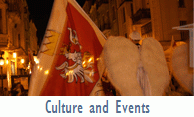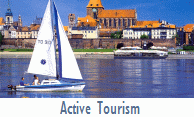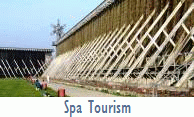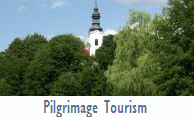|
 Brodnica Intro Brodnica Intro
- town, seat of the Brodnica County (Powiat Brodnicki)
- town privileges: 1298
- number of inhabitants: 27,500
- location: 64 km north-east of Toruń (National road No. 15 Toruń-Olsztyn)
- tourist centre with many of Gothic monuments
- base for exploring the Brodnica Lake District (>>)
Each summer Brodnica is visited by crowds of tourists who thirsty for recreation in a close contact with nature cover canoe and bicycle routes and tramp tracks for walkers that are to be found in the Brodnica Lake District (Polish: Pojezierze Brodnickie). The River Drwęca, one of the cleanest Polish rivers and the biggest ichtyological nature reserve, wind its way throug the town of Brodnica.
The outstanding countryside and a nature amenities set forth the grounds to establish Brodnica Landscape Park (>>). 58 picturesque lakes that lie there among big forests complexes decide about the form of recreation and tourism and attract many lovers of sailing, windsurfing and other water sports. Enthusiasts of canoe flows down waterways can enjoy travelling along the Drwęca, which is a recognized canoeing route in Poland, and stay at riverside hotels located on its banks.
Visitors to Brodnica can stay at any of the hotels in the town or any of a few well-equipped recreation centres in its vicinity. |
|
|
| |
|
| |
|
| |
|
| |
|
| |
|
| |
|
| History of Brodnica |
|
Brodnica Historical Monuments |
The first reference to Brodnica (known as Straisberg) dates back to 1262 and pertains to the destruction of the Teutonic mediaeval castle carried out by the Yotvingias (one of the Baltic tribes). The next reference from 1298 mentions the invasion of the Lithuanians. According to the historians it is the year 1298 which should be regarded as the date of granting Brodnica town privileges by the Teutonic Order. The town belonged to the Teutonic Order till 1479.
Another period of fast development was 1604-1625, when Brodnica was governed by princess Anna Vasa, the sister of the Polish King Sigismond III Vasa. After that, the town was ruined during the wars with Sweden.
During the span of seven centuries Brodnica experienced various periods and - as a border-town - changed hands numerous times. It was under Teutonic, Prussian and German rule before it finally found itself within Poland in 1920.
The residents of the city also fared well and ill. There was a time of recession and poverty as well as periods of economic booms. Despite many historic events and turbulent past many monuments of historic interest preserved in Brodnica.
|
|
• Gothic Church of St. Catherine from the years 1310-1370, founded by the Teutonic Knights. In the years 1554-1598 it was used by Lutherans. After damage in 1631 and 1648 was renewed in the 2nd half of the 17th century. Three-nave hall church with square-closed chancel and the west facade with tower from the 15th century. Inside the 15th-century starlike vaults, fragments of wall murals: Gothic, Renaissance from about 1582, and the Baroque of the turn of the 18th century. Gothic sculptures: 12 apostles at the pillars of the aisle; St. Barbara; St.. James; the crucifix from the 2nd half of the 14th century; group of the Crucifixion from the beginning of the 16th century. Renaissance stalls of 1583.

• Teutonic Castle Ruins from the 14th century with the high tower (56 m high) reserved. The castle was the headquarters of the commander of Brodnica and was one of the most powerful Teutonic castles.
During the 13-year war was occupied by the Polish army in 1454 and 1463. From 1479 to the partition of Poland in 1772 the castle was the seat of Polish mayors (1485-1604 Działyński, and the most famous: princess Anna Vasa 1604-1625). The castle was destroyed during the Swedish wars in the 17th century and in the years 1785-1842 was partially demolished by order of King Frederick II of Prussia.
The castle is adjacent to the northwest part of the city walls, used to protect one of the most important passages on the River Drwęca. Built on a square plan with an inner courtyard, surrounded by a moat and linked to the flowing beside Drwęca.
Currently in the basement of the castle the museum exhibition is located.

• Palace of Anna Vasa - Polish starosts mansion built before 1564 at the Teutonic castle area by the Brodnica County starost Rafał Działyński, partly with the use of the Gothic walls. The palace was rebuilt and expanded as a residence by Anna Vasa of Sweden in the years 1605-1616 then it was the seat of successive starosts. Burned by Russians in 1945 and reconstructed in 1969.
During its existence there resided starosts of prominent families. From the early 17th century Brodnica county was granted to members of the royal family. Besides Anna Vasa of Sweden the Brodnica starosts were: Constance wife of Polish King Sigismund III Vasa, his daughter Anna Catherine, wife of King Wladyslaw IV - Cecilia Renata, and his advisor and the Great Crown Chancellor Jerzy Tęczyn Ossoliński, Maria Kazimiera - wife of John III Sobieski, Crown Hetman Marcin Kalinowski and the Great crown Marshal Marshal Francis Balinski. Currently it houses a library and museum.
• Chełmińska Gate was one of the six entrances to the town. Built in the years 1310-30 and superstructured around 1370, renewed in 1898 with a partial reconstruction of the gable. In the 19th century it was used as a prison. In the 1970s has been adapted to the seat of the museum.
Founded on a square plan, 2-storey with the stepped gable and pinnacles with semicircular plastered blind windows.
• Tower of Gothic Town Hall and actually its top part is the only remaining part of the old town hall, built at the end of the 14th century, burnt down in 1631, and later surrounded by some structures, finally demolished in 1868
• Tower of the Masurian Gate was built about the mid 14th century, in the lower storey square in the upper octagonal.
|
| |
|
| Brodnica Museum |
|
|
Address:
Brodnica, ul. Św. Jakuba 1 (1 St James Street)
65 km north-east of Toruń
Opening hours:
High season (1st June - 15th September): 11am - 6pm
Low season (16th September - 31th May): Tue - Sun: 8am - 3pm | Mon: closed
Admission fees:
5 PLN, reduced: 3 PLN
Further details:
tel/fax (+48) 56 4983698, e-mail: muzeumwbrodnicy@onet.pl
Permanent exhibitions: see here
|
|
| |
| |
| |
| |
| |
| |
| |
| |
| |
| |
| |
| |
| |
| |
| |
| |
| |
| |
| |
| |
| |
| |
| |
| |
| |
|
| Anna Vasa Route |
|
The trail connects the localities closely associated with the activity of the princess Anna Vasa. She was an efficient property owner, patron of the artists and scientists, living in Brodnica and Golub but found her resting place in the Church of the Assumption of the Blessed Virgin Mary in Toruń as in the 17th century that was one of the major Protestant churches in Poland and Anna Vasa was of a Protestant religion.
Toruń (0 km) - Golub (42 km) - Brodnica (73 km)
|
|
| |
|
| River Drwęca |
|
|
The River Drwęca, one of the cleanest Polish rivers and the biggest ichtyological nature reserve, wind its way throug the town of Brodnica.
Drwęca is the biggest Polish ichthyologic reserve and also well-known canoe trail. The meridian, ravine part, from Nowe Miasto Lubawskie to Brodnica estuary, is particularly interesting - the river flows there in a 50-metre-deep valley.
|
|
| |
| |
| |
| |
| |
| |
| |
| |
| |
| |
| |
| |
| |
| |
| |
| |
| |
| |
| |
| |
| |
| |
| |
| |
| |
| |
| |
| |
| |
............................................................................................................................................................................. Surroundings of Brodnica are an interesting tourist area in terms of recreation, active tourism, nature, and the historic tourism. The biggest attraction is the Brodnica Lake District (Polish: Pojezierze Brodnickie) with numerous lakes, forests, recreational centres and Brodnica Landscape Park and numerous nature reserves
|
|
|
Brodnica Landscape Park |
Brodnica Lake District (Polish: Pojezierze Brodnickie) lies in a triangle of railway lines: Brodnica - Jabłonowo Pomorskie - Iława - Brodnica (approximately 180 square km and about 100 lakes). See the map here.
Among the beautiful woodlands there are a tourist and recreational facilities, campsites, camping, marinas, bicycle routes or tramp tracks. The larger recreational centres are Zbiczno on the Lake Zbiczno (9 km north of Brodnica) and Bachotek on the Lake Bachotek with water station (15 km out of Brodnica).
The largest lake is Great Partęczyny (340 hectares) with the island of alder-linden trees (forest reserve with an area of 0.6 hectares) in northern part of the District. There are an interesting waterways, walking and cycling routes in the area. Among the most important nature sights a notice should be given to large boulder size 4 m 75 cm in circumference and 2 m 45 cm in height, it is natural monument located near Zbiczno.
The larger part of the Brodnica Lake Districts is occupied by Brodnica Landscape Park, a type of protected area.
Suggested Reading:
|
|
Brodnica Landscape Park (Polish: Brodnicki Park Krajobrazowy) is a protected area within the central part of the Brodnica Lake District.
The park was established in 1985 as the first in the region of Toruń. Park including the protection zone covers an area of 16,685 hectares and is a very important element in the system of protected areas of northern Poland. Terrain of the park has been shaped under the influence of the last glaciation and is therefore characterized by a great amount of diversity of hight and the diversity and expressivenes of forms.
There are 58 lakes within the park that occupy 8.5% of its area, and most of them are of the ribbon type. Some of these lakes are connected to each other by the network of streams and canals, creating a picturesque system with relatively clean waters, which are a very attractive tourist waterways.
There are 9 nature reserve located in the area of the park. They are of three types: floristic reserves (Wyspa na Jeziorze Wielkie Partęczyny (The Island on the Lake Great Partęczyny), Bachotek) forest reseres (Mieliwo, Retno, Cielęta) and bog reserves (Żurawie Bagno (Crane Bog), Okonek, Stręszek, Mostki).
|
|
Curent local weather in Toruń  | temp. 7.3° C |
|






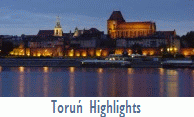
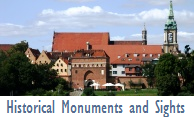
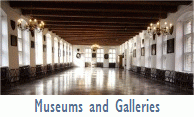
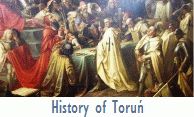
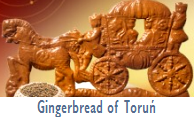
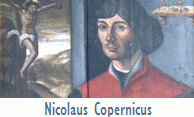
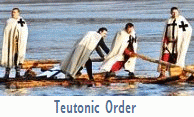






g.gif)









b.bmp)


